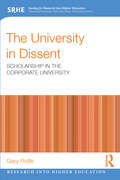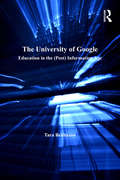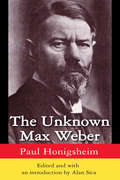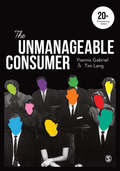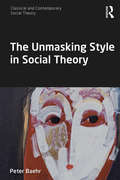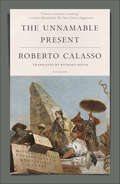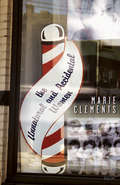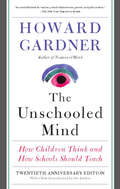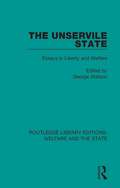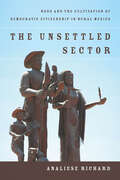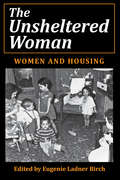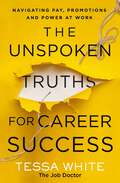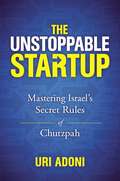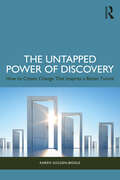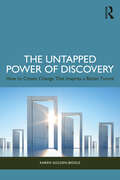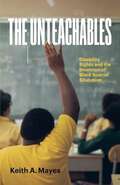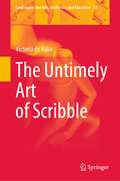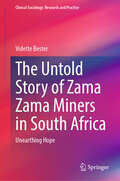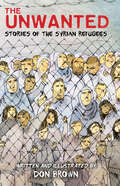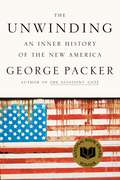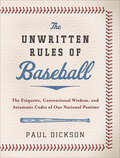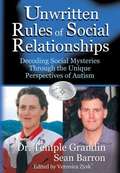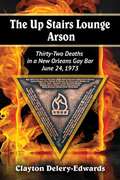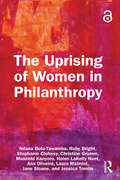- Table View
- List View
The University in Dissent: Scholarship in the corporate university (Research into Higher Education)
by Gary RolfeThe rise of corporatism in the North American University was charted by Bill Readings in the mid nineteen-nineties in his book The University in Ruins. The intervening years have seen the corporate university grow and extend to the point where its evolution into a large business corporation is seemingly complete. Rolfe’s book examines the factors contributing to the transformation of the university from a site of culture and knowledge to what might be termed an ‘information factory’, and explores strategies for how, in Readings’ words, members of the academic community might continue to ‘dwell in the ruins of the university’ in a productive and authentic way. Drawing on the work of critics and philosophers such as Barthes, Derrida, Lyotard and Deleuze, The University in Dissent suggests that this can only be achieved subversively through the development of a ‘community of philosophers’ who are prepared to challenge, critique and subvert the mission statement of the ‘university of excellence’ from within, focusing on how scholarly and academic thought and writing might develop in this new post-Enlightenment era. Summarising, contextualising and extending previous understandings of the rise of corporatism and the subsequent demise of the traditional aims and values of the university, Rolfe assesses the situation in contemporary UK and international settings. He recognises that changes to the traditional idea of the university are inevitable and explores some of the challenges and consequences of this shift in the academic world, suggesting how academics can work with change, whilst at the same time seeking to undermine its worst excesses. This timely and thought provoking book is a must-read for all academics at University level, as well as education policy makers.
The University of Google: Education in the (Post) Information Age
by Tara BrabazonLooking at schools and universities, it is difficult to pinpoint when education, teaching and learning started to haemorrhage purpose, aspiration and function. Libraries and librarians have been starved of funding. Teachers cram their curriculum with 'skill development' and 'generic competencies' because knowledge, creativity and originality are too expensive to provide to unmotivated students and parents obsessed with league tables, not learning. Meanwhile, the internet offers a glut of information on everything-under-the-sun, a mere mouse-click away. Bored surfers fill their cursors and minds with irrelevancies. We lose the capacity to sift, discard and judge. Information is no longer for social good, but for sale. Tara Brabazon argues that this information fetish has been profoundly damaging to our learning institutions and to the ambitions of our students and educators. In The University of Google she projects a defiant and passionate vision of education as a pathway to renewal, where research is based on searching and students are on a journey through knowledge, rather than consumers in the shopping centre of cheap ideas. Angry, humorous and practical in equal measure, The University of Google is based on real teaching experience and on years of engaged and sometimes exasperated reflection on it. It is far from a luddite critique of the information age. Tara Brabazon celebrates the possibilities of digital platforms in education, but deplores the consequences of placing funding on technology and not teachers. In doing so, she opens a new debate on how to make our educational system both productive and provocative in the (post-) information age.
The Unknown Max Weber
by Paul HonigsheimPaul Honigsheim is unique. One of the select few who regularly participated in the Weber-Kreis in Heidelberg during the 1910s, Honigsheim's special place within Weber's world adds a degree of credibility to his writings matched by few others. In the late 1940s Honigsheim published four essays from what might be called Weber's "lost decade," the period during which Weber established his reputation in Germany as the most versatile and brilliant of the younger social scientists. Together in one volume for the first time, these essays reveal portions of Weber's work previously unavailable in English.In the opening essay, "Max Weber as Rural Sociologist," Honigsheim treats Weber's essays on Russia, Poland, and other works in economic history. He offers a point of departure for those wishing to probe Weber's celebrated and misconstrued distaste for traditional Slavic social structure. In "Max Weber as Applied Anthropologist," Honigsheim examines Weber's commitment to the study of race, ethnicity, and nationalism as mediated by ethnic attachments, social policy formation, handicraft economies, and what he calls "Ethno-Politics." "Max Weber as Historian of Agriculture and Rural Life" is a masterpiece of exegesis and comparative inquiry. The final essay, "Max Weber: His Religious and Ethical Background and Development," acts as a minor corrective and addendum to Marianne Weber's biography. The book concludes with Honigsheim's reminiscences of the Weber circle.Interest in the work and person of Max Weber grows with each year. From his writings the reader may glean the finer shades and contours of thoughts that arise from private exchanges between Honigsheim and Max Weber. This volume will interest a broad spectrum of social scientists.
The Unmanageable Consumer
by Professor Tim Lang Professor Yiannis Gabriel‘The Unmanageable Consumer has long been one of my favorite books in the sociology of consumption. This long overdue third edition has updated and revised the basic argument in many ways. Most importantly, it now offers a new chapter on the consumer as worker or, more generally, the prosumer. Assign it to your classes (I have…and will again) and read it for your edification.’ - George Ritzer, Distinguished University Professor, University of Maryland, USA Western-style consumerism is often presented as unstoppable, yet its costs mount and its grip on consumer reality weakens. In this 20th Anniversary edition, Gabriel and Lang restate their thesis that consumerism is more fragile and unmanageable than is assumed by its proponents. Consumerism has been both stretched and undermined by globalization, the internet, social media and other cultural changes. Major environmental threats, debt, squeezed incomes and social inequalities now temper Western consumers' appetite for spending. The 20th century Deal, first championed by Henry Ford, of more consumption from higher waged work looks tattered. This edition of The Unmanageable Consumer continues to explore 10 different consumer models, and encourages analysis of contemporary consumerism. It looks at the spread of consumerism to developing countries like India and China and considers the effects of demographic changes and migration, and points to new features such as consumers taking on unwaged work. New to this edition: Coverage of new phenomenon such as social media and emerging markets Explores contemporary topics including the occupy movement and horsemeat scandal A new chapter on the consumer as worker. 'This is a remarkable and important book. The new edition updates consumer cultural studies to take into account austerity politics and the economic crisis, and the impact these have had on how we think about and experience everyday practices of shopping and consuming. The authors also build on and maintain the lively and challenging argument from the previous volumes which sees the consumer as an unstable space for a multiplicity of often contradictory responses which can unsettle the various strategies on the part of contemporary capitalism to have us buy more.' - Angela McRobbie, Goldsmiths, University of London ‘The book exemplifies how social science should be: engaged, insightful, imaginative, scholarly and highly socially and politically relevant. Strongly recommended to students, academics as well as all people interested in understanding our time and themselves in an age of consumerism and false promises.’ - Mats Alvesson, Professor of Business Administration, Lund University, Sweden
The Unmanageable Consumer
by Yiannis Gabriel Tim Lang‘The Unmanageable Consumer has long been one of my favorite books in the sociology of consumption. This long overdue third edition has updated and revised the basic argument in many ways. Most importantly, it now offers a new chapter on the consumer as worker or, more generally, the prosumer. Assign it to your classes (I have…and will again) and read it for your edification.’ - George Ritzer, Distinguished University Professor, University of Maryland, USA Western-style consumerism is often presented as unstoppable, yet its costs mount and its grip on consumer reality weakens. In this 20th Anniversary edition, Gabriel and Lang restate their thesis that consumerism is more fragile and unmanageable than is assumed by its proponents. Consumerism has been both stretched and undermined by globalization, the internet, social media and other cultural changes. Major environmental threats, debt, squeezed incomes and social inequalities now temper Western consumers′ appetite for spending. The 20th century Deal, first championed by Henry Ford, of more consumption from higher waged work looks tattered. This edition of The Unmanageable Consumer continues to explore 10 different consumer models, and encourages analysis of contemporary consumerism. It looks at the spread of consumerism to developing countries like India and China and considers the effects of demographic changes and migration, and points to new features such as consumers taking on unwaged work. New to this edition: Coverage of new phenomenon such as social media and emerging markets Explores contemporary topics including the occupy movement and horsemeat scandal A new chapter on the consumer as worker. ′This is a remarkable and important book. The new edition updates consumer cultural studies to take into account austerity politics and the economic crisis, and the impact these have had on how we think about and experience everyday practices of shopping and consuming. The authors also build on and maintain the lively and challenging argument from the previous volumes which sees the consumer as an unstable space for a multiplicity of often contradictory responses which can unsettle the various strategies on the part of contemporary capitalism to have us buy more.′ - Angela McRobbie, Goldsmiths, University of London ‘The book exemplifies how social science should be: engaged, insightful, imaginative, scholarly and highly socially and politically relevant. Strongly recommended to students, academics as well as all people interested in understanding our time and themselves in an age of consumerism and false promises.’ - Mats Alvesson, Professor of Business Administration, Lund University, Sweden
The Unmasking Style in Social Theory (Classical and Contemporary Social Theory)
by Peter BaehrThis book examines the nature of unmasking in social theory, in revolutionary movements and in popular culture. Unmasking is not the same as scientific refutation or principled disagreement. When people unmask, they claim to rip off a disguise, revealing the true beneath the feigned. The author distinguishes two basic types of unmasking. The first, aimed at persons or groups, exposes hypocrisy and enmity, and is a staple of revolutionary movements. The second, aimed at ideas, exposes illusions and ideologies, and is characteristic of radical social theory since the eighteenth-century Enlightenment. The Unmasking Style in Social Theory charts the intellectual origins of unmasking, its shifting priorities, and its specific techniques in social theory. It also explores sociology’s relationship to the concept of unmasking through an analysis of writers who embrace, adapt or reshape its meaning. Such sociologists include Vilfredo Pareto, Karl Mannheim, Raymond Aron, Peter Berger, Pierre Bourdieu, Luc Boltanski and Christian Smith. Finally, taking conspiracy theories, accusations of social phobia and new concepts such as micro-aggression as examples of unmasking techniques, the author shows how unmasking contributes to the polarization and bitterness of much public discussion. Demonstrating how unmasking is baked into modern culture, yet arguing that alternatives to it are still possible, this book is, in sum, a compelling study of unmasking and its impact upon modern political life and social theory.
The Unnamable Present
by Roberto CalassoA meditation on the rise of nationalism and totalitarianism in the contemporary world, by the author of The Ruin of Kasch.The ninth part of Roberto Calasso’s masterwork, The Unnamable Present, is closely connected with themes of the first book, The Ruin of Kasch. But while Kasch is an enlightened exploration of modernity, The Unnamable Present propels us into the twenty first century.Tourists, terrorists, secularists, fundamentalists, hackers, transhumanists, algorithmicians: these are all tribes that inhabit the unnamable present and act on its nervous system. This is a world that seems to have no living past, but was foreshadowed in the period between 1933 and 1945, when everything appeared bent on self-annihilation. The Unnamable Present is a meditation on the obscure and ubiquitous process of transformation happening today in all societies, which makes so many previous names either inadequate or misleading or a parody of what they used to mean.Translated with sensitivity by Calasso’s longtime translator, Richard Dixon, The Unnamable Present is a strikingly original and provocative vision of our times, from the writer The Paris Review called “a literary institution of one.”Praise for The Unnamable Present“Calasso is keenly aware of the all-too-namable ills afflicting the contemporary world. His new book differs markedly from its predecessors not only in its brevity but in the urgency with which it addresses the burning issues—the raging inferno—of our time.” —The New York Review of Books
The Unnatural and Accidental Women
by Marie ClementsSurrealist dramatization of a notorious case involving mysterious deaths on Vancouver's Skid Row. Cast of 11 women and 2 men.
The Unschooled Mind: How Children Think and How Schools Should Teach
by Howard GardnerMerging cognitive science with educational agenda, Gardner makes an eloquent case for restructuring our schools by showing just how ill-suited our minds and natural patterns of learning are to the prevailing modes of education. This reissue includes a new introduction by the author.
The Unservile State: Essays in Liberty and Welfare (Routledge Library Editions: Welfare and the State #23)
by George WatsonOriginally published in 1957, The Unservile State looks at the theme of liberty in the Welfare State. Has it survived Welfare – is it even better for it? What of Parliament and our civil liberties? Does the present state of property distribution, of industry, agriculture and our social services satisfy the Liberal mind? And what would a liberal policy for foreign and Commonwealth affairs be like? These are some of the questions which this book sets out to answer. It is the first full scale study of the attitudes and policies of contemporary British Liberalism.
The Unsettled Sector: NGOs and the Cultivation of Democratic Citizenship in Rural Mexico
by Analiese RichardIn late twentieth century Mexico, the NGO "boom" was hailed as an harbinger of social change and democratic transition, with NGOs poised to transform the relationship between states and civil society on a global scale. And yet, great as the expectations were for NGOs to empower the poor and disenfranchised, their work is rooted in much older civic and cultural traditions. Arguably, they are just as much an accomplice in neoliberal governance. Analiese Richard seeks to determine what the growth of NGOs means for the future of citizenship and activism in neoliberal democracies, where a widening chasm between rich and poor threatens democratic ideals and institutions. Analyzing the growth of NGOs in Tulancingo, Hidalgo, from the 1970s to the present, The Unsettled Sector explores the NGOs' evolving network of relationships with donors, target communities, international partners, state agencies, and political actors. It reaches beyond the campesinos and farmlands of Tulancingo to make sense of the NGO as an institutional form. Richard argues that only if we see NGOs as they are--bridges between formal politics and public morality--can we understand the opportunities and limits for social solidarity and citizenship in an era of neoliberal retrenchment.
The Unsheltered Woman: Women and Housing
by Randall HinshawDefining the "unsheltered woman" and her needs is a complicated task. Regardless of the roots of the condition, a significant number of women are not being housed as well as they could be. Women are not the only victims of an inadequately met housing demand; their families suffer as well. This volume provides sources of information for understanding which women are ill-housed and why their shelter is substandard.Birch reviews basic demographic issues and trends in household formation, using census information to reveal which groups in the country and in New York City have housing problems. The essays then turn to the needs of special groups of women: elderly women, working-class women, and professional women - married and single. Later essays investigate locational and design issues related to women's concerns: a model case study in Denver; high-rise housing in New York City; neighborhood housing for the elderly in Manhattan.The author has gathered together more than twenty of the top professionals in the field including Susan Cotts Watkins, Evelyn S. Mann, May Engler, Roberta R. Spohn, Olivia Schieffelin Nordberg, Barbara Behrens Gers, Susan Saegert, Elizabeth Mackintosh, Gwendolyn Wright, Dolores Hayden, Jacqueline Leavitt, Ronnie Feit, Jan Peterson, Michael Mostoller, Clara Fox, Celine G. Marcus, Jane Margolies, Lynda Simmons, Judith Edelman, Rebecca A. Lee, and Michael A. Stegman. The Unsheltered Woman is significant not only for women, but also for housing policy in America. Until now, very little research has focused on gender policy issues, as such it should be read by all urban planners, policy makers, and housing authorities.
The Unspoken Truths for Career Success: Navigating Pay, Promotions, and Power at Work
by Tessa White"A terrific read for the new generations rising in the workforce—and for their leaders."— Stephen M. R. Covey, The New York Times and #1 Wall Street Journal bestselling author of The Speed of Trust and Trust & Inspire STOP SPINNING YOUR WHEELS AND TAKE CONTROL OF YOUR CAREER FUTURE TODAY.Building a successful career in the world of remote work, hybrid schedules, and a lack of work/life balance is not easy. In fact it&’s difficult and often seems impossible. But, it doesn&’t have to be that way. By confronting the lies we are told about building a career, this book will bring you one step closer to the epiphany that will change your life.This workplace manual lays out the truth behind the lies that are fueling the most common career frustrations, including:The truth about pay. Hard work doesn&’t always lead to more money. Learn how to leverage your position to maximize your salary.The truth about promotions. If you want to be considered for a better job title with better pay, you need to be better than your job description. Understand how to build the skills you need to be considered for a promotion.The truth about loyalty. Companies are not designed to return the loyalty you give them. Stop waiting for the praise you&’ve earned and start focusing on your future.The truth about burnout. Work/life balance doesn&’t have to mean taking a step back. Learn to work with your brain and not against it.The truth about office politics and power. You may hate office politics, but they are in every company in every industry. Learn to use the political landscape of your workplace to your advantage. Master these unspoken truths for greater recognition, increased opportunities for pay and promotions, and to provide a path to greater influence and power. The truth can indeed set you free.
The Unstoppable Startup: Mastering Israel's Secret Rules of Chutzpah
by Uri AdoniTHE BOLD SECRET TO SUCCESSFUL STARTUPSVeteran venture capitalist Uri Adoni shares the secrets to Israel&’s incredible track record of success in this new guide that will help make any startup unstoppable.More than half of all startups fail—often during the crucial early stages of development when they need to prove their viability on a limited budget. But when it comes to startup success, one country stands out: Israel. Even though it is a relatively small country with a population of just over 9 million inhabitants, Israel has one of the highest concentrations of startups in the world, has the highest venture capital per capita, is one of the top countries in terms of number of companies listed on NASDAQ, and is well recognized as a global leader in research and development.In The Unstoppable Startup, Uri Adoni goes behind the scenes to explain the principles and practices that can make any startup, anywhere in the world, become an unstoppable one.Packed with insider accounts from leaders who have realized bold visions, The Unstoppable Startup distills Israeli chutzpah into six operational rules that will help you to:Build an unstoppable team;Foresee the future and innovate to meet its demands;Manage your funding and partnerships through all phases of growth;Dominate the market category you are after or create a new one;Build and manage an early stage investment vehicle; andBuild and grow a healthy high-tech ecosystem.Far from mere conjecture, Adoni implemented these practices throughout his more than 12 years as a venture capitalist for one of Israel's most successful venture funds, and he continues to utilize these same proven startup strategies today in metropolitan areas in the US.
The Untapped Power of Discovery: How to Create Change That Inspires a Better Future
by Karen Golden-BiddleDespite being a game-changer in powering human growth, discovery remains a mystery. How can it produce ahas and insights to meet the challenge of new realities and reimagine organizational management? This book lays out a process of inquiry that drives belief change and leads to discoveries, empowering leaders, groups, and the organization with a powerful tool for navigating an uncertain future. Discovery lights the intellectual spark for every breakthrough in science, technology, pharmaceuticals, and more—but fear and inertia can harden beliefs and practices that no longer fit the new realities. To counter this, discovery can be cultivated rather than suppressed, using a new, three-phase process, a management practice that consistently generates the ahas and insights that underpin all transformation. Based on years of research and real-world observation, this book inspires and equips leaders at all levels to champion this discovery process and fuel genuine, sustained change in their communities and organizations.Accompanied by a website that includes proprietary tools, audio and video clips, and a downloadable workbook, this book is an enriching resource for current and aspiring leaders and managers across industries, as well as management consultants, HR professionals, corporate educators, and business students.
The Untapped Power of Discovery: How to Create Change That Inspires a Better Future
by Karen Golden-BiddleDespite being a game-changer in powering human growth, discovery remains a mystery. How can it produce ahas and insights to meet the challenge of new realities and reimagine organizational management?This book lays out a process of inquiry that drives belief change and leads to discoveries, empowering leaders, groups, and the organization with a powerful tool for navigating an uncertain future. Discovery lights the intellectual spark for every breakthrough in science, technology, pharmaceuticals, and more—but fear and inertia can harden beliefs and practices that no longer fit the new realities. To counter this, discovery can be cultivated rather than suppressed, using a new, three-phase process, a management practice that consistently generates the ahas and insights that underpin all transformation. Based on years of research and real-world observation, this book inspires and equips leaders at all levels to champion this discovery process and fuel genuine, sustained change in their communities and organizations.Accompanied by a website that includes proprietary tools, audio and video clips, and a downloadable workbook, this book is an enriching resource for current and aspiring leaders and managers across industries, as well as management consultants, HR professionals, corporate educators, and business students..
The Unteachables: Disability Rights and the Invention of Black Special Education
by Keith A. MayesHow special education used disability labels to marginalize Black students in public schoolsThe Unteachables examines the overrepresentation of Black students in special education over the course of the twentieth century. As African American children integrated predominantly white schools, many were disproportionately labeled educable mentally retarded (EMR), learning disabled (LD), and emotionally behavioral disordered (EBD). Keith A. Mayes charts the evolution of disability categories and how these labels kept Black learners segregated in American classrooms.The civil rights and the educational disability rights movements, Mayes shows, have both collaborated and worked at cross-purposes since the beginning of school desegregation. Disability rights advocates built upon the opportunity provided by the civil rights movement to make claims about student invisibility at the level of intellectual and cognitive disabilities. Although special education ostensibly included children from all racial groups, educational disability rights advocates focused on the needs of white disabled students, while school systems used disability discourses to malign and marginalize Black students.From the 1940s to the present, social science researchers, policymakers, school administrators, and teachers have each contributed to the overrepresentation of Black students in special education. Excavating the deep-seated racism embedded in both the public school system and public policy, The Unteachables explores the discriminatory labeling of Black students, and how it indelibly contributed to special education disproportionality, to student discipline and push-out practices, and to the school-to-prison pipeline effect.
The Untimely Art of Scribble (Landscapes: the Arts, Aesthetics, and Education #34)
by Victoria de RijkeThis book offers new definitions, vocabularies and insights for “scribbling”, viewing it as a fascinating and revealing process shared by many different disciplines and practices. The book provides a fresh and timely perspective on the nature of mark making and the persistence of the gestural impulse from the earliest graphic marks to the most sophisticated artistic production. The typical treatment of scribbling in the literature of artistic development has cast the practice as a prelude to representation in drawing and writing, with only occasional acknowledgment of the continuing joy and experiment of making marks across many arts practices. The continuous line the author traces between the universal practice of scribbling in infancy and early childhood and the work of radical creativity for contemporary and historical artists is original and clarifying, expanding the range of drawing behaviors to that of avant-garde painters, performance and the digital.
The Untold Story of Zama Zama Miners in South Africa: Unearthing Hope (Clinical Sociology: Research and Practice)
by Vidette BesterThis book results from a decade of in-depth research on the complexities of Zama Zama mining in South Africa, which has become a pressing issue of late. It critiques the overly simplistic portrayal of the miners negatively and as illegal immigrants. Through a sociological lens, this book explores the broader socio-economic conditions, the profound impact of South Africa&’s mining history, particularly the migrant labor system, on today&’s Zama Zama miners, and the role of women in the sector. This book is not just about mining; it interrogates issues around language, poverty, and power. It challenges dominant societal narratives and examines how labels can further marginalize vulnerable groups. Inspired by the works of Pierre Bourdieu and Michel Foucault on classification and language, the book questions who holds the power to label and shape mainstream discourses. Amplifying the voices of the Zama Zamas themselves, the book transforms the conversation around Zama Zama mining in South Africa and beyond, providing fresh insights into this complex and marginalized sector. This book is more than an original and insightful study on informal mining – it offers practical initiatives for businesses, government, and civil society to engage with and address this marginalized sector more sustainably.
The Unwanted: Stories of the Syrian Refugees
by Don BrownSibert Honor Medalist · New York Public Library Best Of 2018 · The Horn Book&’s Fanfare 2018 list · Kirkus Best Books of 2018 · YALSA Excellence in Nonfiction WinnerIn the tradition of two-time Sibert honor winner Don Brown&’s critically acclaimed, full-color nonfiction graphic novels The Great American Dust Bowl and Drowned City, The Unwanted is an important, timely, and eye-opening exploration of the ongoing Syrian refugee crisis, exposing the harsh realities of living in, and trying to escape, a war zone. Starting in 2011, refugees flood out of war-torn Syria in Exodus-like proportions. The surprising flood of victims overwhelms neighboring countries, and chaos follows. Resentment in host nations heightens as disruption and the cost of aid grows. By 2017, many want to turn their backs on the victims. The refugees are the unwanted. Don Brown depicts moments of both heartbreaking horror and hope in the ongoing Syrian refugee crisis. Shining a light on the stories of the survivors, The Unwanted is a testament to the courage and resilience of the refugees and a call to action for all those who read.
The Unwinding: An Inner History of the New America, First Edition
by George PackerA riveting examination of a nation in crisis, from one of the finest political journalists of our generation.<P><P> American democracy is beset by a sense of crisis. Seismic shifts during a single generation have created a country of winners and losers, allowing unprecedented freedom while rending the social contract, driving the political system to the verge of breakdown, and setting citizens adrift to find new paths forward. In The Unwinding, George Packer, author of The Assassins' Gate: America in Iraq, tells the story of the United States over the past three decades in an utterly original way, with his characteristically sharp eye for detail and gift for weaving together complex narratives.<P> The Unwinding journeys through the lives of several Americans, including Dean Price, the son of tobacco farmers, who becomes an evangelist for a new economy in the rural South; Tammy Thomas, a factory worker in the Rust Belt trying to survive the collapse of her city; Jeff Connaughton, a Washington insider oscillating between political idealism and the lure of organized money; and Peter Thiel, a Silicon Valley billionaire who questions the Internet's significance and arrives at a radical vision of the future. Packer interweaves these intimate stories with biographical sketches of the era's leading public figures, from Newt Gingrich to Jay-Z, and collages made from newspaper headlines, advertising slogans, and song lyrics that capture the flow of events and their undercurrents.<P> The Unwinding portrays a superpower in danger of coming apart at the seams, its elites no longer elite, its institutions no longer working, its ordinary people left to improvise their own schemes for success and salvation. Packer's novelistic and kaleidoscopic history of the new America is his most ambitious work to date. <P>National Book Award 2013
The Unwritten Rules of Baseball: The Etiquette, Conventional Wisdom, and Axiomatic Codes of Our National Pastime
by Paul DicksonFrom beanballs to basebrawls, the most important rules governing the game of baseball have never been officially written down—until now.They have no sanction from the Commissioner, appear nowhere in any official publication, and are generally not posted on any clubhouse wall. They represent a set of time-honored customs, rituals, and good manners that show a respect for the game, one's teammates, and one's opponents. Sometimes they contradict the official rulebook. The fans generally only hear about them when one is bent or broken, and it becomes news for a few days. Now, for the first time ever, Paul Dickson has put these unwritten rules down on paper, covering every situation, whether on the field or in the clubhouse, press box, or stands. Along with entertaining baseball axioms, quotations, and rules of thumb, this essential volume contains the collected wisdom of dozens of players, managers, and reporters on the secret rules that you break at your own risk, such as:1.7.1. In a Fight, Everyone Must Leave the Bench and the Bullpen Has to Join In1.13.3. In a Blowout Game, Never Swing as Hard as You Can at a 3-0 Pitch5.1.0. In Areas That Have Two Baseball Teams, Any Given Fan Can Only Really Root For One of Them
The Unwritten Rules of Social Relationships: Decoding Social Mysteries Through the Unique Perspectives of Autism
by Temple Grandin Sean BarronBorn with autism, Sean Barron and Temple Grandin now famously live successful social lives. But their paths were very different. Temple's logical mind controlled her social behavior. She interacted with many adults and other children, experiencing varied social situations. Logic informed her decision to obey social rules and avoid unpleasant consequences. Sean's emotions controlled his social behavior. Baffled by social rules, isolated and friendless, he made up his own, and applied them to others. When they inevitably broke his rules, he felt worthless and unloved. Both Temple and Sean ultimately came to terms with the social world and found their places in it. Whether you are a person with autism, a caregiver in the autism community, or just someone interested in an "outsider" view of society, their powerful stories will enthrall and enlighten you.
The Up Stairs Lounge Arson: Thirty-two Deaths in a New Orleans Gay Bar, June 24, 1973
by Clayton Delery-EdwardsOn June 24, 1973, a fire in a New Orleans gay bar killed 32 people. This still stands as the deadliest fire in the city's history. Though arson was suspected, and though the police identified a likely culprit, no arrest was ever made. Additionally, government and religious leaders who normally would have provided moral leadership at a time of crisis were either silent or were openly disdainful of the dead, most of whom were gay men. Based upon review of hundreds of primary and secondary sources, including contemporary news accounts, interviews with former patrons of the lounge, and the extensive documentary trail left behind by the criminal investigations, The Up Stairs Lounge Arson tells the story of who frequented this bar, what happened on the day of the fire, what course the investigations took, why an arrest was never made, and what the lasting effects of the fire have been.
The Uprising of Women in Philanthropy
by Musimbi Kanyoro Ana Oliveira Helen LaKelly Hunt Ndana Bofu-Tawamba Ruby Bright Stephanie Clohesy Christine Grumm Laura Risimini Jane Sloane Jessica TomlinThe Uprising of Women in Philanthropy tells the inspiring, never-before-told, story of the Global Women’s Funding Movement—considered the women’s movement’s greatest secret—and how it enabled women from all walks of life to harness the power of money to free themselves from oppression.Brimming with feminist epiphanies, this social justice playbook is an urgent call for women’s collective leadership to guide humanity through the gravest of challenges, overcoming patriarchy’s multi-millennium reign through the uprising of women leaders and philanthropists. Founded during the second-wave women’s movement of the early 1970s, small groups of women across the world, independent of each other, had the same epiphany: it will take a movement of women to raise the money needed to fund women’s freedom. Since then, the Global Women's Funding Movement has grown into a global network of radically generous, risk-taking philanthropists who collectively wield financial might to win seismic gender equality victories. The authors document the "Women Effect" that results from gender equality and women’s collective leadership, including improved public health and reproductive justice, expanded public education, stronger democracies, resilient economies, climate recovery and enduring peace. The Global Women's Funding Movement is guided by its Feminist Funding Principles and, through them, it has innovated the most effective philanthropic practices, including trust-based philanthropy.The Uprising of Women in Philanthropy is for those interested in focusing the power of philanthropy on leveraging systemic social justice victories and gender equality gains. The long-practiced Feminist Funding Principles imparted by the authors is a recipe for the feminist alchemy needed to transform society for the betterment of all.
